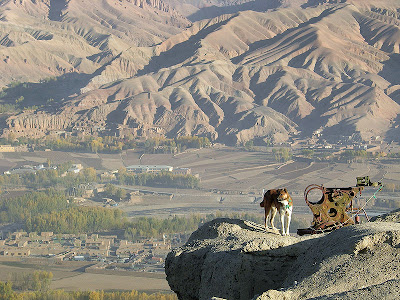
Bamiyan: Wonderful of the World Heritage
Shovelbum.com
The giant Afghan Buddhas, carved into a mountainside at Bamiyan in the heart of the Hindu Kush mountains, were among Asia’s great archaeological treasures.
The larger statue stood at 53 metres (125 feet) above the town of Bamiyan [possibly the original Kapilavastu, where Siddhartha grew up before becoming the Buddha] -- as high as a 10-storey building.
It was considered to be the [largest and] most remarkable representation of the Buddha anywhere in the world. At one time, it and a 38-metre-high companion were painted in gold and other bright colors. And they were decked in dazzling ornaments.
All around there was a synthesis of Greek, Persian [Indo-Iranian/Aryan], Central Asian, and South Asian art. There were countless rich frescoes.
On one cave wall, there remain traces of a painting of Buddhas in maroon robes strolling in fields of flowers. In another painting, milk-white horses draw the Sun God’s golden chariot [vimana, space ship, UFO] through a dark blue sky.
Bamiyan was a place of pilgrimage. There were 10 Buddhist monasteries built into the cliff [a labyrinth of caves and crevices] -- the home of saffron-robed Buddhist monks and nuns, who presided over festivals.
For a short time, the 1960's hippy trail passed through Bamiyan. It became a hub for a new kind of traveler. But Afghanistan’s 20 years of civil war put a stop to that. The area played an important strategic role.
For many years it was the stronghold of the Hezb-i-Whadat party, the main faction of the Shi’a Muslims of the center of the country.
Hezb-i-Whadat is a member of the Northern Alliance which opposes the purist [CIA-created] Taliban movement. They apparently approached the site with a mixture of suspicion and disinterested neglect.
It became variously an ammunition dump and home to dozens of families displaced by the war [who took up residence in the caves]. Those who visited Bamiyan said this treatment was threatening the integrity of the monuments and structures.
The Hezb were driven out by the Taliban in the campaigns of 1997 and 1998. Despite their abhorrence of idols and un-Islamic images, the Taliban initially assured the international community that the site would come to no harm.
But that restraint has now been dropped [thanks almost certainly to CIA pressure], apparently in the belief that there is little to be gained from bowing to the sensibilities of the outside world.
 The CIA by vilifying the extremist Taliban -- which it created from released prisoners in neighboring countries, according to Fitzgerald and Gould -- was intent on creating a pretext to attack and invade the entire country of Afghanistan while claiming to be rooting out just the Taliban. With 9-11 and Osama bin Laden/Emmanuel Goldstein, it found a fertile narrative to justify the US's longest war ever. The real interest the US has in controlling Afghanistan follows the history of many previous empires (British, Indian, Persian, Central Asian, Russian, Roman, Greek). It is a strategic interest to control the region by launching attacks from a centralized base and airstrips. The other dominant interest is an oil pipeline that had already been arranged and contracted before the US invaded. There is a great deal of money to be made and influence to be exerted. Meanwhile, ancient Buddhism falls by the wayside. Now China is extracting mineral riches and demolishing the world's largest Buddhist archeological site and Afghan monastery at Mes Aynak.
The CIA by vilifying the extremist Taliban -- which it created from released prisoners in neighboring countries, according to Fitzgerald and Gould -- was intent on creating a pretext to attack and invade the entire country of Afghanistan while claiming to be rooting out just the Taliban. With 9-11 and Osama bin Laden/Emmanuel Goldstein, it found a fertile narrative to justify the US's longest war ever. The real interest the US has in controlling Afghanistan follows the history of many previous empires (British, Indian, Persian, Central Asian, Russian, Roman, Greek). It is a strategic interest to control the region by launching attacks from a centralized base and airstrips. The other dominant interest is an oil pipeline that had already been arranged and contracted before the US invaded. There is a great deal of money to be made and influence to be exerted. Meanwhile, ancient Buddhism falls by the wayside. Now China is extracting mineral riches and demolishing the world's largest Buddhist archeological site and Afghan monastery at Mes Aynak.

